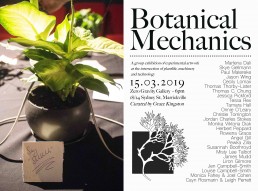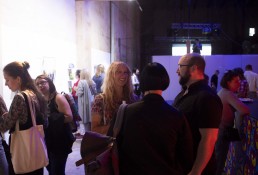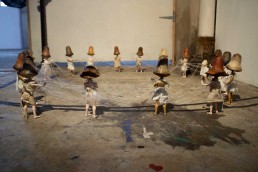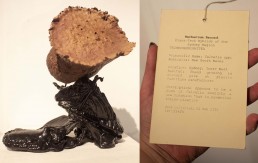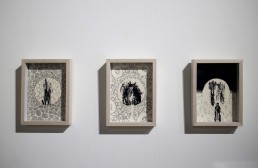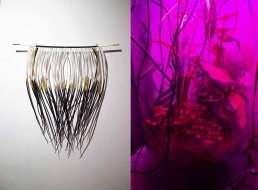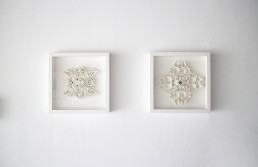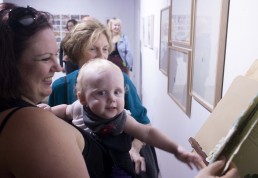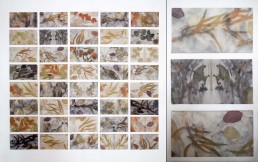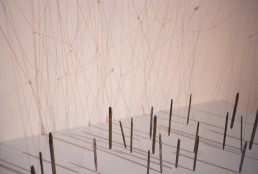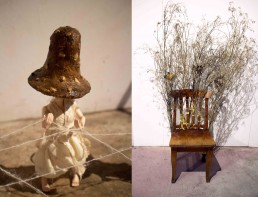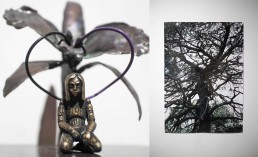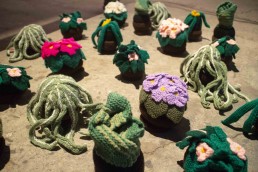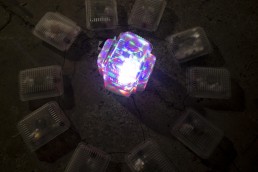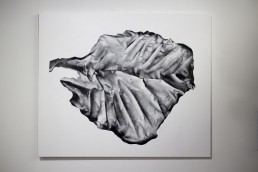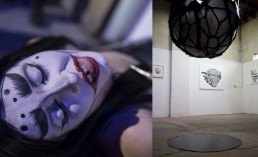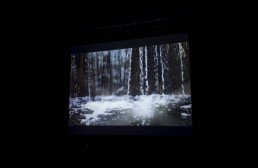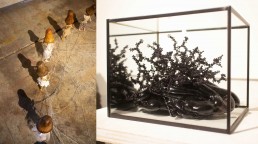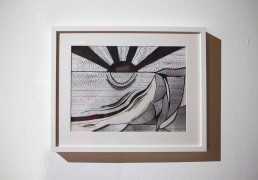
Botanical Mechanics: Zero Gravity Gallery
Curated by: Grace Kingston
Exhibiting artists:
Paul Matereke, Jason Wing, Cecily Lomax, Thomas Thorby-Lister, Thomas C. Chung, Tessa Rex, Tamara Hall, Jessica Pickford, Onnie O’Leary, Christie Torrington, Jordan Charles Stokes, Monika Viktoria Diak, Herbert Peppard, Rowena Grace, Angel Gill, Pewka Zilla, Susannah Boothroyd, Misty Lee Talbot, James Mudd, Liron Gilmore, Jen Campbell-Smith, Louise Campbell-Smith, Monica Fahey & Joel Cohen, Cayn Rosmarin & Leigh Perrett, Marlena Dali, and Skye Gellmann
The methods and systems in which plant-life communicate, grow, feed, mobilise and reproduce is fascinatingly sophisticated. Surprisingly, many of these processes and systems are mirrored in our contemporary, technologically activated lives. Botanical Mechanics brought together a diverse selection of artists, scientists and creative practitioners to explore these intersections and to muse on how we might better work with and learn from the natural environment. I curated this large-scale survey of works to better inform my ongoing inquiries into this diverse area of research.
The opening night on Friday the 15th of April featured two gravity-defying live performances by Skye Gellmann and Marlena Dali of ‘The Oyster Club’ and Fringe Festival fame. Skye performed a durational work ‘Actuality Machine’, a piece influenced by aerial performance and architectural brutalism. Marlena Dalí brought a foreboding yet camp durational, interactive performance combining grotesque drag, clowning, story-telling, and climate activism. The gallery space is located in a repurposed warehouse boasting three story high walls, which is ideal for large-scale installation work and dramatic, scene-setting lighting. Musician James Mudd created a live work using colour, movement and other properties of plant life to control a modular synth, in a similar way to how a doctor would monitor the vital statistics of a patient, but completely repurposed – essentially you could hear plants to experience plant life in a way that isn’t visual.
Indigenous artist Jason Wing created a sculptural installation memorial to the Aboriginal resistance warrior Pemulwuy who led a resistance against the colonial frontier for over twelve years. Wing has said “Pemulwuy is a symbol of strength, resilience, power, and more, yet there is no significant memorial to this incredible leader and freedom fighter”. The works themselves were humble in size, but cast dramatic kinetic shadows on the gallery walls. Jewellery artist Susannah Boothroyd also employed the use of light and shadow in her dainty diorama-like installation ‘Wood Wide Web’ which saw a series of hand-forged silver and copper pendants meticulously intertwined referencing the underground mycelium webs that trees use to communicate to one another within a forest system.
Multi-disciplinary artist Cecily Lomax engaged in the Posthuman research of bioorganic and tech symbiosis, this consolidated as a large hanging meditation on the future of our intertwined forms. Ceramicist Tamara Hall painstakingly printed and hand-painted a delicate triptych of flat ceramic works based on the imprint of reproductive organs throughout their fertility cycle. These were complimented by the dainty human-fungus female effigies produced by Monika Viktoria Diak that stood hauntingly in a coven-like mycorrhizae connected circle a few meters away. Small bio-fusion works were also produced by Herbert Peppard, but these creatures were more lonesome – both characters were connected to a fine flower rendering, with the whole work seeming more of a fragile specimen then their bronze and copper materiality let on.
There were also a number of moving image and new-media works displayed; filmmaker Paul Matereke created a documentary ‘Blue Ribbons’ based on the machine-based destruction of the natural environment at the hands of the state governments’ intervention in to Sydney Park for the WestConnex Project. While filmmaker Tessa Rex took on a larger environmental evil with her work ‘SHELL still = HELL’ injecting her iconic humour throughout this found-footage mashup. Multi-disciplinary artist Pewka Zilla recreated a steely looking plant-based environment pixel by pixel to create an interactive game work that investigates identity within the intersection of online and offline worlds.
Scientific inquiry was activated in the gallery with a collaborative moss work from Botanic Gardens research scientist/Macquarie PhD candidate Monica Fahey and researcher Joel Cohen. Monica’s research uses methods in DNA genotyping technology and environmental modelling to investigate the influence of past climate change and dispersal vectors on the distribution and speciation of Australian native flora. Installation artist and architect Jessica Pickford used similar modelling technology for her contribution – an intricate pair of organically mirrored shapes informed by leaf formations printed in 3D ceramic. Similarly, Thomas Thorby-Lister’s large-scale monochrome paintings were developed through the study of 3D scanned organic plant forms.
Liron Gilmore installed a powerful large-scale mix media work; ‘Ocellus (To Turn Harm Away)’ references the bold markings displayed on the wings of insects. Eye-shaped markings are laboriously hand-wrapped and colour blocked in yarn, while loops of thread replace the eye beads common to ‘evil-eye’ charms. Sisters Louise and Jen Campbell-Smith also presented a series of multi-disciplinary works, however their offerings investigated electricity, machinery and nature. Jen used EEG scans of her own brainwaves to highlight the survival instinct similarities between botanical and human life. While Louise employed a huge variety of methodologies including painting, sculpture, and found object installation to make fusion works that discuss the ephemerality of organic and inorganic life cycles. Misty-Lee Talbot used the natural dye of plants as a mark-making tool on silk, the sumptuous series of tiles revealed trace elements of botany that can be recorded and arranged in a pattern suggesting a unique language emerging from the plant specimens.
Scale and interwoven botanical networks were explored contrastingly by photographer Jordan Charles Stokes and Thomas C Chung. Jordan’s large-scale print of an ancient tree branch network almost eclipsed the viewer, while Thomas’ small hand-knitted plant works invited the viewer to crouch down child-like, and admire the labour-intensive process required to render each element of the small sculptures. Admiration and observation was echoed in the work of Cayn Rosmarin and Leigh Perrett who worked collaboratively to build, monitor and journal the experience of small plant life being cultivated in a terrarium. Mechanic influence was also suggested in the quirky assemblage sculpture works of Rowena Grace. Rowena used a mix of organic objects and industrial refuse to create a series of imagined natural history artefacts, each with their own information panel to satirically explain their origins.
Finally, a number of finely crafted painted, drawn and collaged works were shown from (in)famous Sydney artists Onnie O’leary, Christie Torrington and Angel Gill who reinterpreted the concept of a botanical drawings by bringing them into the 21st century. Their intricate, yet unsettling pieces looked as though they would be at home in a speculative future botany journal. The huge range of intriguing and experimental work is a testament to the broad talent of the Sydney arts community.
Image Credits: Grace Kingston & Kimberley Brewster
Botanical Mechanics was held at Zero Gravity Gallery, Mothership studios, Marrickville between the 15th and 24th of April, 2019.
Year2019


